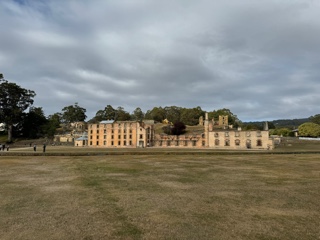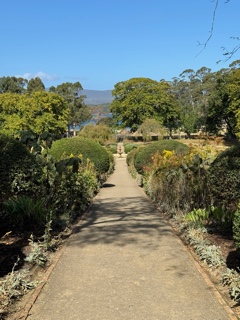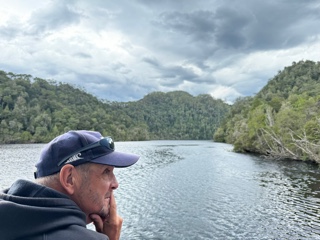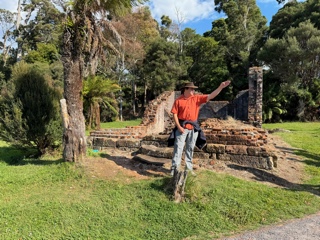No more convicts thank you

Casamara
John & Susan Simpson
Mon 1 Apr 2024 07:07
When planning our trip to Tasmania we had in mind that it would be a bit like the Isle of Wight and we’d be able to zip across it easily in a few hours. Wrong! The two islands might be a similar shape but the Isle of Wight covers 150 square miles and Tasmania covers 26,000 square miles. Not only that but more than a quarter of Tasmania is designated as a UNESCO World Heritage site for the extent of its remote wilderness, so there aren’t many roads! Anyway, we spent a pleasant 10 days there and drove an anti-clockwise circle from the airport at Hobart to Port Arthur, the Freycinet Peninsula, Launceston, Cradle Mountain, Strahan and back to Hobart. I’d always thought Freycinet was a made up name for that fizzy wine that comes in the cut glass bottles so it came as a surprise to find that it's a real place, and that Tasmania produces very good sparkling wine and champagne. Our tour of Tasmania amounted to just under 750 miles driving in total, this time in a Toyota. What, no KIA? Tasmania was where the British sent the people who’d been transported to Australia for crimes committed in the UK and who had then offended again in Australia. It was meant to be a place with a tough enough reputation to be a deterrent from further offending. We were moved by the stories of the convicts but also those of the people who chose or were sent to work with them. It must have been hard to try to live a ’normal’ life in this island wilderness far from home. It was incredible how, in a very short space of time, they created somewhere like the Port Arthur penal colony where they reclaimed land, built the equivalent of a small town, dockyards and timber processing plant and even found time to plant formal gardens. Admittedly they did have forced labour to do it but the site was only operational for 50 years and an imposing set of buildings still remains to show for their efforts. We were also astonished to learn how the British class system was also in place here in the most difficult of circumstances. There was a story of a young army officer commanding a small group of soldiers guarding the narrow entrance to the peninsula where Port Arthur was located. His wife had accompanied him and wrote to her sister in England that she had had no other female conversation apart from her maid for the past three months. And yet there was also reference to babies being born to the numerous women who had accompanied the soldiers so there were definitely other women there, but not of the right class!  Port Arthur convict accommodation  Port Arthur formal gardens Having recently been in New Zealand we felt that Tasmania was similar in many ways but ’New Zealand Lite’. It is as sparsely populated, has equally impressive landscape, breathtaking views and an outdoorsy lifestyle but with everything feeling a little softer. Tasmania was also much more arid than New Zealand had been and as we flew into Hobart we were amazed at how brown and dry the land was. By contrast, we would find the opposite on the western side of the island. Tasmania’s west coast mountains catch the rain so that the air is dry by the time it reaches the eastern side. Therefore whilst Tasmania is one of the wettest states in Australia, Hobart is one of its driest cities. We’ve been very impressed by the hiking trails in both Australia and New Zealand. They are generally very well defined and signposted so are easy to follow even without a map. That’s probably a good thing in Australia which is home to some of the deadliest creatures in the world. Keeping to the path is to be advised! The Australian bush is also so dense that it would be nigh on impossible to walk through it without a good set of sharp tools. We stayed in an alpine log cabin in the Cradle Mountain National Park and did a lovely long circular walk up into the park. No traffic is allowed in the park during daylight hours and a very efficient shuttle bus service ferried everyone from the visitor centre to bus stops where various different walks started. Our walk took us scrambling up into the mountains and past some lakes, one of which was called Wombat Pool. As we’d also climbed over Wombat Peak we were hopeful that we would see a Wombat whilst we were walking. It was sod’s law that we completed the challenging 8.5 km course without seeing a single Wombat until we got within 25 metres of the bus stop where we’d started and there was a Wombat ambling its way across an open patch of grass! A wombat From the mountains in the centre of Tasmania we went to Strahan (pronounced Strawn) on the west coast, but not before we’d had a quick stop in a town called Zeehan. It was my birthday and the plan was to stop in Zeehan for coffee and cake. Unfortunately the 5* cafe promised by Google was shut so it was a quick takeaway coffee and biscuit instead! Zeehan had been Tasmania’s mining capital and a very prosperous town, originally silver was mined and then tin. Some of the big 19th century buildings still line the High Street and mining still takes place there but it did feel as though Zeehan’s glory days were passed. Here and in Strahan we saw some magnificent steam engines and heavy industrial equipment giving an idea of just how busy the area once was. The main street in Zeehan Steam engines in Zeehan. The central one was in service 1884-1961 and the right hand one from 1900-1961. From Strahan we took a river cruise on the Gordon River from where the river meets the Southern Ocean - the river entrance is ominously called ‘Hell’s Gates’ - up the river into the temperate rainforest that covers the UNESCO World Heritage wilderness area. We disembarked for a fascinating tour of a tiny corner of the rainforest and learned about some of the trees and plants. The forest is incredibly dense and moist, almost totally green because there are few flowers and those that do exist are very tiny. The darkness and density of the forest means there’s no place for showy flowers as they would serve no purpose. We were told that the plants that grow here have more in common with those in Antartica than anywhere else. The north-western tip of Tasmania has a monitoring station measuring the quality of the earth’s air and feeding the data into scientific work on climate change. Air measured here is some of the cleanest in the world because the strong winds buffeting the coast have travelled thousands of miles over the Southern Ocean from Antartica. It is regarded as baseline air because it has not been influenced by other environmental and atmospheric conditions.  John surveying the surrounding wilderness from the deck of the curiously named vessel ‘Harbour Master II’. That must cause a bit of confusion when they have to radio the Harbour Master! Naturally the river cruise also stopped at a former 19th century British penal colony in the middle of the river - it wouldn’t be Tasmania without a convict story. Sarah Island was the first of Tasmania’s penal colonies to be built and the twenty acre island once housed up to 1,200 convicts. All that remains on the island now are the crumbling remains of houses of the prison officers and the walls of one of the buildings which housed the convicts. The story of a group of convicts who escaped on a ship they had built in Sarah Island’s shipyard had been made into the play ‘ he ship that never was’ and we spent a hilarious evening watching it. Two actors tell the story whilst inviting members of the audience to participate in playing the remaining eight characters. It was a cross between historical drama, improvisation and pantomime. We cried with laughter it was so funny.  Sarah Island tour - the guides were also the actors in the play later in the day Driving back into Hobart after the wilderness we were plunged suddenly into suburbia, dual carriageways and traffic. It felt like a real culture shock. We loved Hobart’s harbour waterfront and its Salamanca market area full of quirky shops, bars and restaurants. We could have visited the Cascades Female Factory, a house of correction for female convicts transported to Australia, but we decided we couldn’t take any more convict stories. Instead we went to the Maritime Museum and to the Museum of Old and New Art (MONA), a mixture of art exhibition, historical artefact collection, live music, food, wine and other stuff. It has a reputation for being a bit whacky and sometimes shocking but we thoroughly enjoyed the experience and it rounded off our tour of all that Tasmania has to offer very nicely. Next on our itinerary is Western Australia, starting from Perth. Australia is such a vast continent and country that Perth is in a time zone 3 hours behind Hobart, and it will take 5 hours to fly between the two cities. |